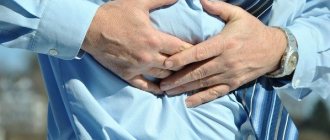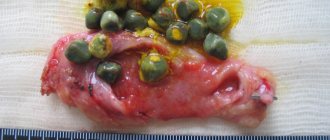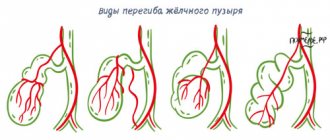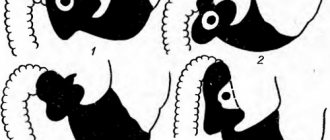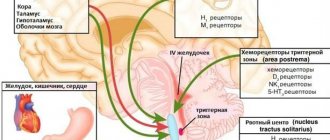Risk group for cholecystitis
Not everyone develops cholecystitis and, even if a person’s nutrition is far from ideal, he can live with a healthy gallbladder all his life. There are risk factors that increase the chances of developing the disease.
- Genes. If your relatives suffered from cholecystitis, you are also at risk.
- Weight jumps. Both weight gain and weight loss are stressful for the body. Often this process is associated with changes in diet - strict diets or overeating, fasting or eating more fatty foods.
- Alcohol abuse.
- Diabetes types 1 and 2.
- Metabolic disorders.
- Taking COCs, especially between the ages of 30 and 45 years.
- Pregnancy and other hormonal changes.
- Other gastrointestinal diseases are Crohn's disease, cirrhosis and fatty liver hepatosis, congenital pathologies of the gallbladder.
- Helminthic infestations.
Medicines used in the treatment of diseases of the liver and biliary tract
Drugs for the treatment of the liver, depending on the mechanism of pharmacological action, can be divided into 3 large groups.
- Hepatotropic:
- choleretic (choleretics, cholekinetics);
- cholelitholytic;
- hepatoprotectors.
- Etiotropic:
- antiviral,
- antibacterial,
- antifungal,
- antiprotozoal.
- Symptomatic:
- antispasmodics (neurotropic, myotropic);
- analgesics;
- anti-inflammatory drugs;
- antiemetics;
- vitamins;
- detoxifying (including antidotes);
- corticosteroids;
- anticytokines;
- probiotics.
Symptoms of cholecystitis
There are two main forms of cholecystitis - acute and chronic.
Spicy
. If stones get into the bile ducts, a blockage occurs, the organ tissues are damaged by bile and inflammation develops. Everything happens quickly. Often, a person with biliary colic is taken straight to the emergency room to have the gallbladder removed.
Symptoms: severe sharp pain in the area where the organ is located (on the right, in the liver area), nausea and vomiting, constipation, increased body temperature, fever, yellowness of the eyes.
Chronic cholecystitis
. It develops slowly and often unnoticed by the patient. The pain may be unobtrusive and only intensify if you eat a large amount of heavy food or are in a serious stressful situation.
Symptoms: dull pain in the organ area, heaviness and poor digestion, bitter taste in the mouth, nausea, bloating, constipation, low-grade body temperature (37*C).
If you notice the symptoms listed above, hurry up and see a doctor before it becomes a severe attack.
!Never use the tubage method (warming the liver with lemon juice and oil) to treat or prevent disease. This may result in the removal of the gallbladder.
Types of liver damage
- Infectious diseases (viral hepatitis).
- Toxic lesions (alcohol, drugs, etc.).
- Autoimmune diseases.
- Diffuse lesions of the liver parenchyma (metabolic disorders).
- Vascular pathologies of the liver.
- Storage diseases (hemochromatosis, etc.).
- Liver helminthiasis.
- Benign and malignant tumors.
Depending on the location of the pathological process, liver diseases are divided into:
- for diseases of the liver parenchyma and interstitial connective tissue;
- damage to the bile ducts;
- pathologies of the vessels of the portal system and hepatic veins.
Review of the best choleretic drugs
The list of good choleretic drugs is extensive. These medications quickly cope with the manifestations of diseases, have few restrictions on use and side effects. Before starting therapy, read the instructions and follow the recommended dosages.
Allohol
A medicine with choleretic and cholekinetic properties. Ingredients: extract of bile, garlic, nettle, activated carbon. The tablets enhance the process of bile formation and activate the motor and secretory functions of the gastrointestinal tract.
Additionally, Allochol has a mild laxative effect and improves the process of breaking down fatty foods.
When to take Allohol:
- chronic hepatitis;
- inflammatory processes in the gallbladder, bile ducts;
- constipation caused by intestinal atony;
- with the gallbladder removed for normal bile movement.
Dosage for adults – 2 tablets with an interval of 8 hours after meals, with an exacerbation, 1. Duration of treatment – 3-6 weeks. The break between courses is 3 months. Improvement in the condition occurs on days 5-8 of taking the medicine - pain decreases, dyspeptic disorders disappear.
Children under 7 years of age are prescribed 1 tablet in the morning, afternoon and evening. For children over 7 years old – adult dosages.
During treatment, adverse reactions rarely occur. Mostly allergic manifestations and stool disorders are observed.
Contraindications – acute form of hepatitis and pancreatitis, liver dystrophy, stones in the gall bladder or ducts, peptic ulcer of the gastrointestinal tract.
Price – 70-115 rub.
Hofitol
Plant choleretic with field artichoke leaf extract. Release form: tablets, suspension, syrup for oral administration.
A drug with hepatoprotective, choleretic effect, normalizes metabolic processes. The medicine activates the process of formation and movement of bile, prevents the development of atherosclerosis.
Indications:
- nausea, bloating, discomfort in the central abdominal area;
- chronic non-calculous cholecystitis, hepatitis;
- slowing down the outflow of liver secretions with biliary dyskinesia;
- cirrhosis;
- renal failure, chronic form of nephritis.
Hofitol is prescribed as an auxiliary drug for intoxication with salts of heavy metals or alkaloids, obesity, anorexia, atherosclerosis, and urolithiasis.
Directions for use: drink three times a day before meals. Dosages – adults and children over 12 years old – 2-3 tablets. Course – 2-3 weeks. Dosage regimen for children 6-12 years old – 1-2 tablets.
Single dosages of medication in liquid form for children:
- Up to a year. Dilute 5-10 drops of the drug in 5 ml of water.
- 1-5 years. 10-20 drops, dissolve in 15 ml of water.
- Over 6 years old. Dissolve 2-3 ml or 40-60 drops in 15 minutes of water.
The container with the suspension must be thoroughly shaken before use; the artichoke extract will settle to the bottom.
Side effects occur with long-term use of the drug in high dosages. Possible negative reactions are abdominal cramps, heartburn, upset stool, nausea. Rarely, hypersensitivity reactions occur - rash, itching, skin hyperemia.
The drug is not prescribed for individual intolerance, bile duct obstruction, cholelithiasis, or diseases of the urinary system in the acute stage. Hofitol tablets are contraindicated in children under 6 years of age.
Price – 470-580 rub.
Holosas
An effective natural remedy containing rosehip extract. It has a complex effect - improves the flow of bile, promotes the restoration of liver cells, eliminates manifestations of the inflammatory process, strengthens the immune system. Holosas reduces the permeability of small blood vessels, accelerates the regeneration process and the synthesis of hormones, and is involved in the metabolism of carbohydrates.
Indications for use:
- viral hepatitis;
- cholecystitis, cholangitis;
- deficiency of vitamin C, P;
- poisoning with drugs, alcoholic beverages;
- increased physical and mental stress.
Dosage for children over 12 years of age and adults – 5 ml 2-3 times a day half an hour before meals. The average duration of therapy is 15-30 days.
The medicine should not be taken if there is intolerance to the components, cholelithiasis, and should be taken with caution if you have diabetes. The syrup is contraindicated for children under 12 years of age, pregnant and lactating women. Possible side effects are allergic manifestations, stool upset, bloating, flatulence.
Average price – 100-200 rubles.
Holenzym
Combined choleretic action tablets from the group of natural bile acids.
Practiced with:
- gastrointestinal pathologies;
- chronic hepatitis, cholecystitis, pancreatitis;
- gastritis;
- colitis;
- bloating;
- diarrhea of non-infectious origin.
Dosage: 1 tablet after meals at intervals of 8-24 hours.
Possible adverse reactions are caused by allergic manifestations:
- sneezing;
- lacrimation;
- redness and swelling of the skin;
- rashes.
It is strictly forbidden to take when:
- acute pancreatitis or exacerbation of the chronic form of the disease;
- obstructive jaundice;
- hypersensitivity to components.
The price of tablets No. 50 is 250-300 rubles.
Papaverine
Synthetic antispasmodic, active ingredient – papaverine hydrochloride. The drug has a relaxing effect on smooth muscles.
Papaverine will help cope with spasms and pain due to cholecystitis and spastic colitis. The medicine is prescribed before surgical interventions on the gallbladder.
Tablet dosage regimen:
- children from 1 year to 12 years – maximum single dose 200-300 mcg/kg;
- adults - 0.04-0.06 g orally, dosage frequency 3-5 times a day.
Possible side effects are tachycardia, decreased blood pressure, dyspeptic disorders, drowsiness.
Contraindications:
- individual intolerance;
- violation of intracardiac conduction;
- glaucoma;
- severe forms of renal failure;
- less than 6 months old.
The medicine is prescribed with caution for chronic renal failure, shock, hypothyroidism, and malfunction of the adrenal glands.
Price – 35-90 rub.
Odeston
A synthetic choleretic agent, the main ingredient is hymecromone. A complex action medicine – improves the synthesis and movement of bile, relaxes the bile ducts, analgesic, antispasmodic.
Odeston's indications:
- chronic form of non-calculous cholecystitis, cholangitis, cholelithiasis;
- impaired motility of the biliary tract, sphincter of Oddi;
- after surgical interventions on the organs of the biliary system;
- lack of appetite, problems with defecation, vomiting caused by bile hyposecretion.
Take the medicine 30 minutes before meals. Dosage regimen for adults – 1-2 tablets every 8 hours. Duration of therapy is 14-21 days.
The recommended dosage for children over 7 years old is 1 tablet 1-3 times a day. The treatment course is 2-3 weeks.
The medicine sometimes provokes the development of allergies, dyspeptic disorders, ulcers of the mucous organs of the gastrointestinal tract, migraine attacks and dizziness.
Odeston should not be taken if you have kidney or liver failure, blockage of the bile ducts, ulcerative colitis, Crohn's disease, or hemophilia. The drug is not prescribed to children under 7 years of age.
Price – 430-880 rub.
Flamin
Herbal preparation with extract of immortelle flowers. Cholekinetic, choleretic, anti-inflammatory, antimicrobial, antispasmodic.
Tablets or granules help with inflammation of the gallbladder, ducts, and liver.
Take the medicine before meals. Dosage for tablets – 1-3 times a day. Duration of treatment is 1.5-6 weeks.
Children are prescribed the drug in granules, from which a suspension is prepared.
Single dosage for children:
- 1-12 months – 2.5 ml;
- 1-3 years – 5 ml;
- 4-5 years – 7.5 ml;
- over 5 years – 10 ml.
Course duration is 10-14 days.
Allergic reactions may occur during treatment. With hypertension, blood pressure may increase.
The medicine should not be taken if you have hypersensitivity, cholelithiasis, or obstructive jaundice.
Price – 170-300 rubles.
Magnesia
Magnesium sulfate, when taken orally, has a choleretic, laxative, and antispasmodic effect.
The medicine will help with cholangitis, cholecystitis, constipation, and gallbladder dyskinesia. The drug is effective before duodenal intubation to obtain a cystic portion of bile.
As a choleretic agent, dissolve 20-25 g of powder in 100 ml of water. Drink 15 ml solution 3 times a day before meals.
Contraindications:
- hypertension;
- bradycardia, AV block;
- severe forms of chronic renal failure;
- depression of the respiratory center.
The price of 1 sachet is 20-28 rubles.
Ursosan
{banner_banstat9}
The drug contains ursodeoxycholic acid. Hepatoprotector with choleretic, immunomodulatory effects.
Indications:
- uncomplicated forms of cholelithiasis;
- prevention of stone formation when the gallbladder is removed;
- biliary dyskinesia;
- acute, chronic active hepatitis, primary biliary cirrhosis.
The Ursosan treatment regimen is selected individually, depending on the type and severity of the disease. The standard dosage is 2-5 capsules per day. The duration of therapy ranges from 2-3 months to several years.
Contraindications:
- chronic hepatitis, pancreatitis;
- disabled gallbladder;
- acute form of cholecystitis, cholangitis;
- decompensated cirrhosis of the liver;
- acute infectious pathologies of the gallbladder;
- renal, liver failure;
- pregnancy, breastfeeding period.
Possible adverse reactions are vomiting, diarrhea, exacerbation of psoriasis, back pain, allergies, alopecia.
Price for 10 capsules – 180-190 rubles.
Types of choleretic drugs
Medicines that increase the flow of bile are divided into 2 groups according to their mechanism of action - choleretics and cholekinetics.
Classification:
1. Choleretics. They increase the volume of bile secreted and the concentration of acids.
- True choleretics - Allohol, Liobil. The products contain liver enzymes, animal bile, and extracts from medicinal herbs.
- synthetic choleretics - Nicodin, Cyclalon. They have a choleretic effect, relieve inflammation, eliminate spasms, and fight pathogenic bacteria;
- choleretics of plant origin - Cholagol, Chofitol. Contains extracts from herbs and plants. Helps improve bile movement, reduce secretion viscosity, improve liver function;
- natural bile acids, often of animal origin – Cholenzyme. Active substances – crushed mucous membrane of the small intestine, pancreas, animal bile.
- Hydrocholeretics. Mineral medicinal waters – Essentuki, Smirnovskaya, Slavyanskaya. Salts improve the production of bile and dilute it.
- 2. Cholekinetics – promotes the passage of bile into the intestines.
- Cholekinetic agents. Atropine, Magnesia. They relax the bile ducts by stimulating the contractile functions of the gallbladder, eliminate congestion, and prevent their occurrence.
- Cholespasmolytics. Relaxes smooth muscles, eliminates pain.
- Synthetic – Drotaverine, Papaverine;
- Natural – St. John's wort tincture.
Preparations to prevent the formation of gallstones with ursodeoxycholic acid - Ursosan.
The classification of drugs that have a choleretic effect is conditional; many drugs have a complex effect.
Causes
Causes of development of acute cholecystitis:
- Impaired outflow of bile from the gallbladder into the bile ducts, contributing to the development of pathogenic secondary microflora and impaired blood supply to the walls of the gallbladder
- Blockage of the cystic duct with a stone
Causes of chronic cholecystitis:
- In the presence of a stone in the gall bladder, periodic inflammation occurs, followed by frequent exacerbations and remissions, ultimately leading to dystrophic changes in the wall of the gallbladder
- Parasitic diseases (giardiasis, opistarchosis)
- Atherosclerotic changes in the arteries supplying the wall of the gallbladder with impaired blood supply
According to the etiological factors, cholecystitis is:
- Calculous (with the presence of a stone or groups of stones in the gallbladder)
- Non-calculous (stoneless)
Principles of treatment
Active treatment measures begin only when stones provoke acute inflammation or exacerbation of chronic inflammation, blocking the ducts of the bladder. There are several approaches and methods for treating cholelithiasis: conservative and surgical. Cholecystectomy (surgical removal of stones) is the second most common operation in the world, followed by appendectomy (removal of the appendix due to its inflammation - appendicitis). According to statistics, every year in the USA the operation is performed on more than half a million patients, in Russia - more than 110 thousand people.
